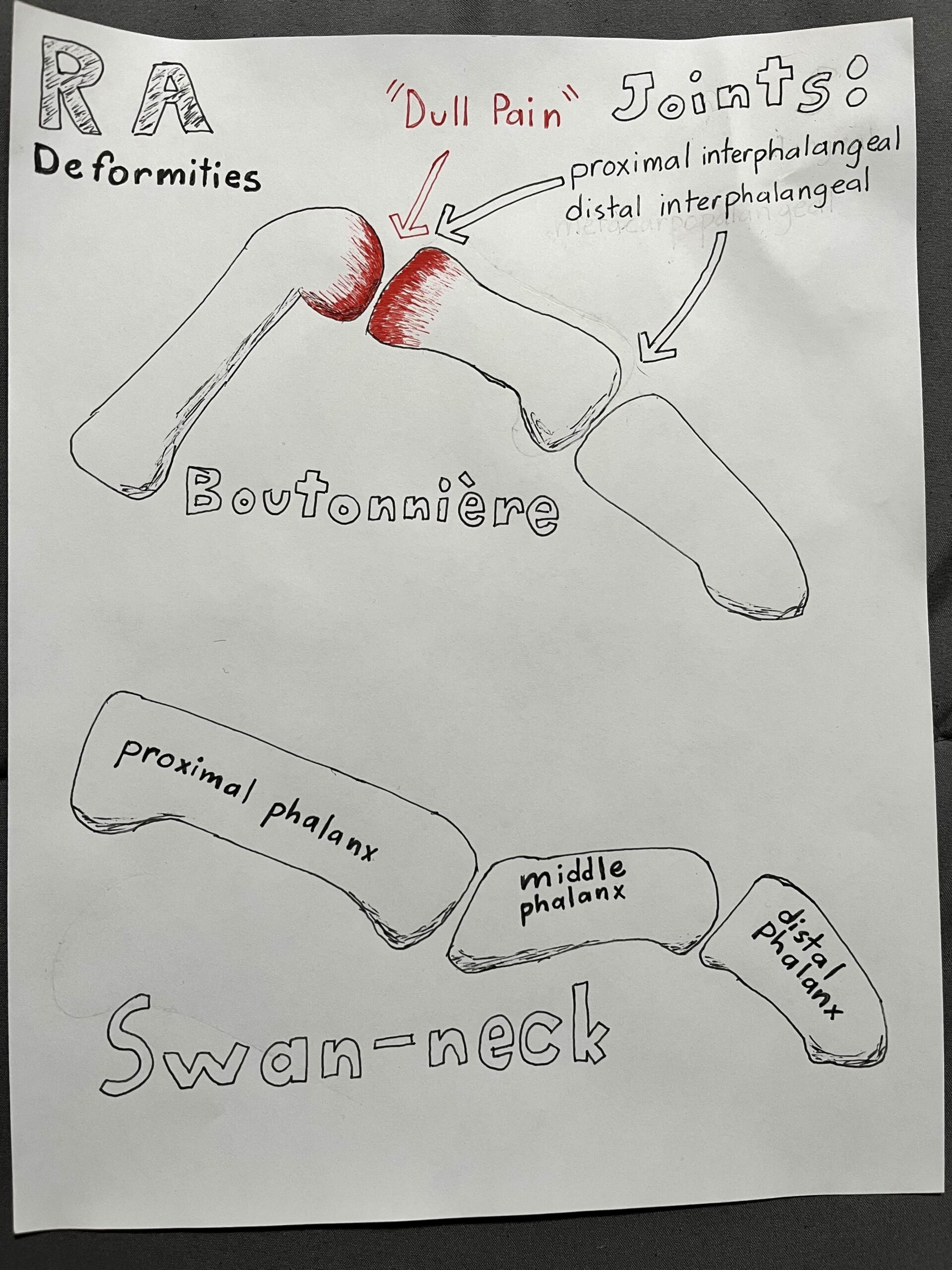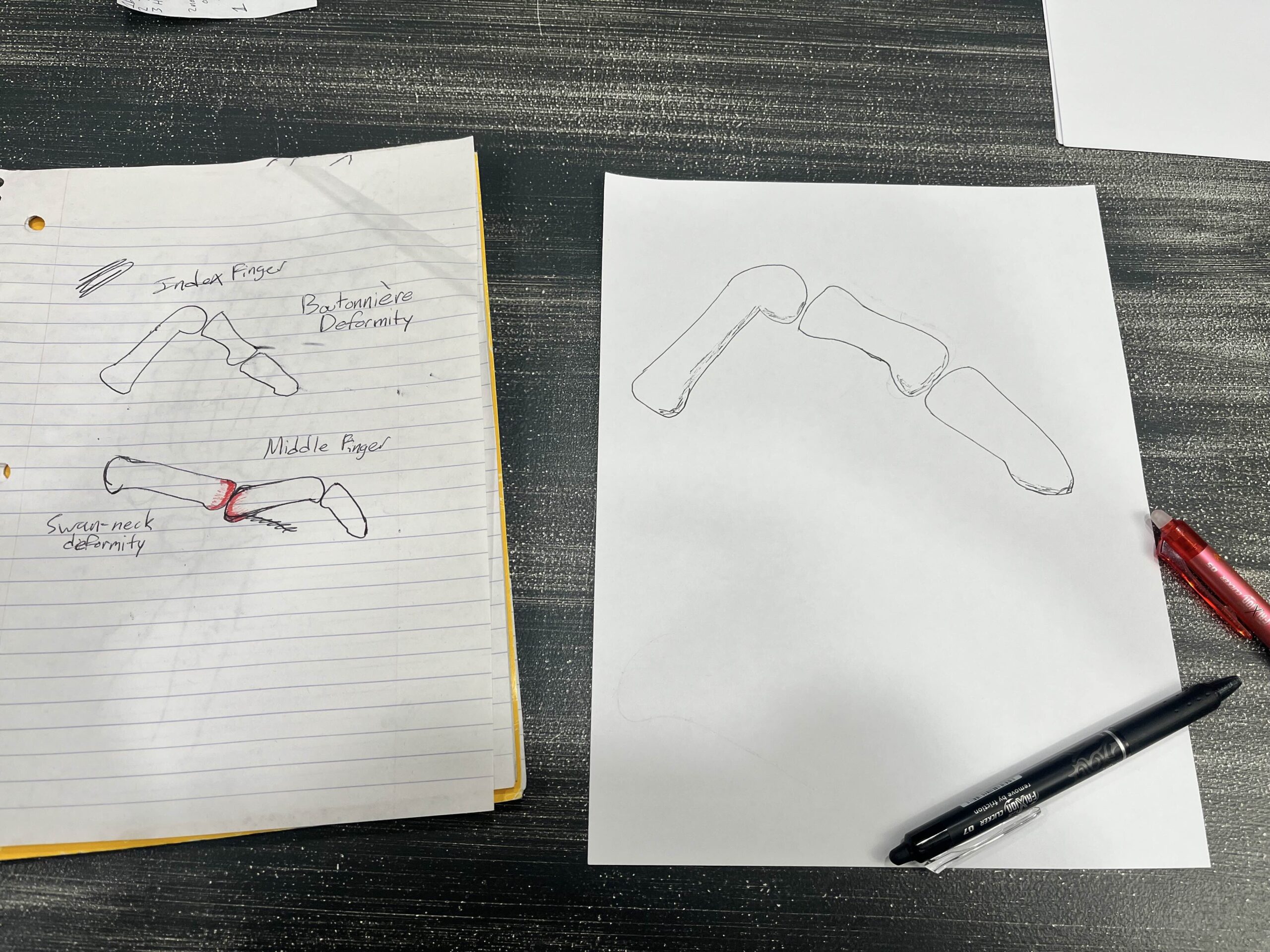

Rheumatoid Arthritis (RA) is a chronic joint disease that causes inflammation of the joints and can be damaging to the bones and cartilage of the body, this topic relates to the objectives “Know the parts of the bone and their shape”, “Know the structure of the knee joint and compare this joint type to other 5 joint types”, “Know the location of bones listed”, and “Know the list of bones provided in blackboard”. RA can occur in jointed areas of the body such as the fingers, wrists, shoulders hips, knees, elbows, ankles, and toes. Unlike Osteo Arthritis, which is arthritis caused by wear and tear on the joints, Rheumatoid Arthritis is an autoimmune disease where the immune system attacks the synovium of the joints causing inflammation, leading to pain/ discomfort and deformity, and it can stem from a few different factors (1). RA can be inherited genetically, which puts people who have family members with RA at a higher likeliness of getting the disease. Genes such as the HLA-DRB1 gene and more specifically the “shared epitope” variant, has been found to be heavily linked to RA and are part of the genetic side of inheriting it. Another factor that has been observed as increasing the risk of having RA is smoking. Smoking can “rub elbows” with genetic predispositions by engaging with genes, such as the HLA-DRB1 gene, which can lead to increased risk of developing or intensifying RA symptoms (2).
There are deformities that can be side effect to suffering from RA. Some common deformities of the hand caused by RA (called Rheumatoid hand) are Ulnar drift, boutonniere deformity, and swan-neck deformity. Ulnar drift can be described as the phalanges of the fingers having a slight tilt towards the Ulna bone of the arm. Boutonniere deformity appears as a stiffly bent form of the proximal interphalangeal joint. Swan-neck deformity is the opposite of boutonniere deformity, since swan-neck is a stiffly locked out form of the proximal interphalangeal joint. The severity of these deformities and when they can occur in a person with RA varies with factors such as how long the person has been having symptoms, and when the person started treatment and how effective it was at the time (3).
As far as treatments go for Rheumatoid Arthritis, there are many different types of treatment options in existence, some of which include disease-modifying antirheumatic drugs (DMARDs) and biologics. The goal of these treatments is to reduce inflammation caused by the disease, prevent joint damage, and to try and control the symptoms. With a disease like Rheumatoid Arthritis and how it can compound into a big issue over time if left unaddressed, catching it in its early stages and beginning treatment is considered crucial. Combination DMARDs therapy was found to be most effective in combatting the disease when compared to monotherapy DMARD treatments such as methotrexate and sulfasalazine in a study done by M Kristen Demoruelle and Kevin D Deane (4).
My project media is an illustrated depiction of two different types of hand deformities that can occur with Rheumatoid Arthritis, Boutonniere and Swan-neck. I also labeled the bones and joints that were relevant. The reason the words “dull pain” have quotations is because that is how it was described to me by my grandmother, who has had Rheumatoid Arthritis for the past thirty years, when I asked her how she would describe the pain in her hands. She was also the inspiration for me to pick RA as my topic for this project.
(1)
Mayo Clinic Staff. (2023, January 25). Rheumatoid arthritis. Mayo Clinic. https://www.mayoclinic.org/diseases-conditions/rheumatoid-arthritis/symptoms-causes/syc-20353648
(2)
Smolen, J. S., Aletaha, D., & McInnes , I. B. (2017, March 22). Rheumatoid arthritis. CORE. https://core.ac.uk/reader/77600864?utm_source=linkout
(3)
Toyama, S., Tokunaga, D., Tsuchida, S., Kushida, R., Oda, R., Kawahito, Y., & Takahashi, K. (2021, February 27). Comprehensive assessment of alterations in hand deformities over 11 years in patients with rheumatoid arthritis using cluster analysis and analysis of covariance. Arthritis research & therapy. https://pmc.ncbi.nlm.nih.gov/articles/PMC7913439/#Sec14
(4)
Demoruelle, M. K., & Deane, K. (2012a, October 14). Treatment strategies in early rheumatoid arthritis and prevention of rheumatoid arthritis. Current rheumatology reports. https://pubmed.ncbi.nlm.nih.gov/22773387/

Rheumatoid arthritis is a joint disease that causes inflammation of the joints. Knowing the parts of the bone and their shape is beneficial. Rheumatoid arthritis can be found in the fingers, wrist, shoulders, knees, elbows, ankles, and toes. Another type of arthritis is osteo from wear and tear but RA is an autoimmune disease. RA can be caused by genes and smoking. The gene that causes RA is HLA-DRB1 which is a shared epitope. Deformities can be caused by RA such as ulnar drift, boutonniere deformity, and swan neck deformity. Boutonniere deformity is when there is a stiffy bent of the proximal interphalangeal. The swan-neck deformity is a stiff locked-out form of the proximal interphalangeal joint. There are different treatments for RA such as disease-modifying antirheumatic drugs and biologics. DMARD therapy is very effective when treating RA. The treatments reduce inflammation to help prevent joint damage and control the symptoms caused by Rheumatoid arthritis. If this is caught early treatment is more effective. If left untreated Rheumatoid arthritis can become a bigger issue. The deformities are the cause of pain. This is described as dull pain by Kylums grandfather.